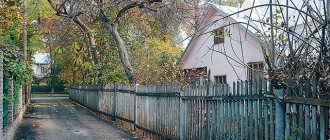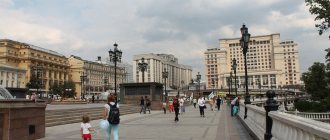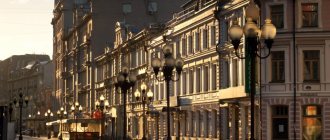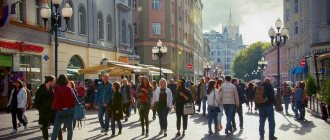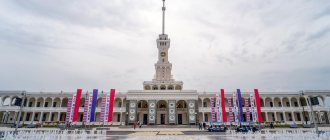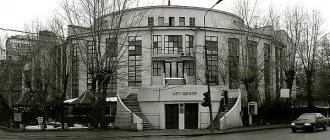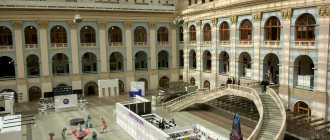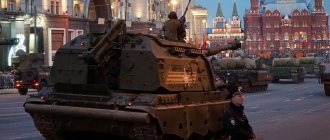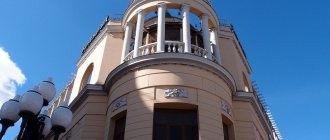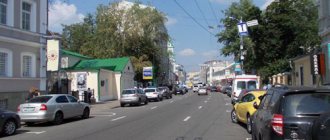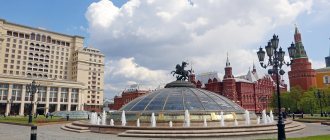Ilyinka Street is one of the oldest in Moscow and was one of the three main streets on the territory of the once existing Kitay-Gorod.
Ilyinka is located in the center of Moscow. It originates from Red Square and stretches to another - Ilyinsky Gate. The length of the street is only 550 meters.
At the time of its foundation, the street began at the Kremlin Spassky Gate, called Frolovsky in the fifteenth century. Then it continued to Bolshoi Cherkassky Lane, on the site of which a defensive ditch was built.
Ilyinka - origin of the name
The first name assigned to this street dates back to the 14th-15th centuries. Then she was called Dmitrovka or, in another manner, Dmitrievka. The name came from the church that stood here - in the name of Dmitry of Thessalonica.
Ilyinka street began to be called already in the sixteenth century after the construction of the Ilyinsky Monastery with the main church in memory of Elijah the Prophet, which stood on the Dmitrovsky Krestets.
Ilyinka (Yandylet pochinta)
The village of Ilyinka is located 8 km southeast of the center of the village council, the village of Markovo.
In 1921, pochinok was founded by people from the village of Yandyletkovo, Starokreshchensky village council. The first to move to a new place of residence were Ilya, Vasily and Fedor Permyakov, Ivan, Egor and Nikita Moskvichev, Ya.I. Moskvichev. Later they moved D.I. Kudryavtsev, T. Kudryavtsev with families. The settlers settled 400 m east of the Tsarevokokshaisk - Yaransk road. Pochinok was located along the Pelengerka River and was named after the first settler, Ilya.
In 1922, there were 10 farms in the Ilyinka village, inhabited by 52 people. Houses were built along the left side of the road to the village of Staroye Kreshcheno, only 2 houses were on the right side. Residents were engaged in field farming, livestock farming, gardening, and were hired for various jobs in the village of Staroye Kreshcheno. I.E. was engaged in the cooperage trade. Moskvichev.
In 1924, in the Ilyinka village of the Starokreshchensky village council of the Orsha canton, 52 people lived in 11 farms, Mari. Common surnames are Moskvichevs and Permyakovs.
In May 1930, the Sorla collective farm was created, with V.N. serving as chairman. Permyakov. All repair farms joined the collective farm. Residents celebrated Peter's Day and Epiphany.
During the Great Patriotic War, Ya.I. died at the front. Moskvichev, E.N. Moskvichev, N.T. Kudryavtsev, M.T. Kudryavtsev.
In 1949, in the Ilyinka settlement of the Starokreshchensky village council, 15 men, 26 women, and 16 children lived on 11 farms. The children studied at the Starokreshchenskaya eight-year school.
In 1951, the Sorla collective farm was merged with the Stalin collective farm (Ivanovka village). Ya.I. was elected chairman. Shornikova. 16 men, 21 women, 13 children lived in 9 households.
In 1953, residents of the village of Ilyinka became part of the Zvezda collective farm (Novinsk village, Shuika). In 1954, 10 men, 27 women, and 20 children lived in 10 households. Electricity and radio were installed in the village, and the collective farm purchased cars.
In 1960, the Zvezda collective farm was merged with the Comintern collective farm (the villages of Maly Kugunur, Pishtenger, Sukhoi Ovrag, Komary). Village residents sold their products at the Yoshkar-Ola market.
In 1964, the collective farm was split into 3 collective farms. The village of Ilyinka became part of the collective farm “Zvezda” (center - the village of Novinsk), F.G. was elected chairman. Vokhmintseva. 12 men, 19 women, 20 children lived in 11 households. The children studied at Starokreshchenskaya and Markovskaya schools.
In November 1970, the Zvezda collective farm was merged with the Prozhektor collective farm (center - the village of Markovo). During these years, no houses were built in the village of Ilyinka. There were 11 men, 20 women, 13 children living there. Part of the population worked at the Prozhektor state farm, at the Ilyinskaya PMK, and at enterprises in the village of Orshanka.
The Yoshkar-Ola - Ilyinka highway passes through the village. In 2003, 11 people, pensioners, lived in 7 farms. The houses in the village were built thirty to fifty years ago, 2 were built in 1995-2000. There is no running water. Residents go to the store in the village of Orshanka, in the villages of Staroye Kreshcheno and Ivanovka. They use imported gas.
V.V. was born in the village of Ilyinka. Moskvichev, he graduated from the aviation school, the Moscow Dzerzhinsky Academy, served in Germany, in the Leningrad region, has the rank of lieutenant colonel, works at the training center of the Ministry of Internal Affairs of Mari El.
https://www.12rus.ru/List/30/2233/
History of Ilyinka
The birthplace of the street was popularly called Merchant because of the Gostiny Dvors that stood here. Mentions of the trading place are found in the chronicles of the reign of Ivan III, in particular, in his spiritual charter.
From documents dating back to the 17th century, it is known that in Gostiny Dvors there were more than 200 rows with a large number of shops - about 4000.
Numerous monastery farmsteads were also located on Ilyinka: Novgorodskoye, Iosifovskoye, Voskresenskoye, Troitskoye, Alekseevskoye.
The Ambassadorial Courtyard was set up to provide accommodation for ambassadors arriving in Moscow. It was located on the territory bounded by Posolsky Lane (now Nikolsky) and the church in the name of Dmitry of Thessaloniki (the Exchange was later built on the site of the religious building).
The history of the Ambassadorial Compound ended by 1717. By this time, it was already empty as unnecessary, and the manufactory of Apraksin, Tolstoy, and also Shafirov was located on the territory. The terrible Moscow fire of 1737, among other things, destroyed the Podvorye.
The year 1680 in the history of Ilyinka is notable for the construction of the stone church of St. Nicholas the Great Cross. The building was built with the money of the Filatiev merchants. The traditions of building charitable institutions of that time provided for the construction of basements under churches. The Nikola Filatievs used this lower floor of the church as a warehouse for their goods.
The radical reconstruction of Ilyinka began during the reign of Catherine II (the Great).
Exchange Square, designed by architect Ivan Starov, is being built on the street. True, at the very beginning it had a slightly different name - Karuninskaya Square, named after the manufacturer Karunin, who lived nearby.
In the 80s of the nineteenth century, construction began on Ilyinka and philistine houses, arranged in such a way that the first floors were allocated for shops. During these years their number reached 60.
The years 1790-1810 are significant for the construction of the Gostiny Dvor by the architect Kvarnegi.
Ilyinka Street was seriously damaged by the fire of 1812. Added to the natural disaster were the consequences of a strong explosion of a mine planted behind the Kremlin wall.
The destroyed shopping arcades were demolished, and new ones were built in their place, according to the design of the architect Beauvais.
In 1839, they decided to demolish the church in the name of Dmitry Solonsky, and the Exchange building was erected on the vacated territory, rebuilding it in 1875.
In connection with the further increase in the status of Ilyinka as the financial and commercial center of the capital, a significant reconstruction of the territory begins here.
In 1891, the Middle Trading Rows appeared to organize wholesale trade. On the opposite side, in 1893, the current GUM (Upper Trading Rows) was erected.
The monastery farmsteads are also being rebuilt, in particular the Joseph and Trinity Lavra of St. Sergius.
Financial institutions were represented by the Construction Insurance Company and large banks: St. Petersburg International, Russian Foreign Trade, Volzhsko-Kama and others.
During the years of Soviet power, various government institutions were located on Ilyinka Street, which continue to be located there in modern Russia.
How to get to Ilyinki Street? By metro – Kitay-Gorod station.
Ilyinka Street
This was the main street of Kitai-Gorod, or Bolshoi Posad, an ancient settlement east of the Kremlin, where artisans and merchants were the first to settle. In 1535-1538, to protect against military attacks, the settlement was surrounded by a brick wall with a gate running along the line: Moskvoretskaya Embankment - Kitaysky Proezd - Old and New Squares - Teatralny Proezd - Revolution Square. Four centuries later, these walls were dismantled, their remains were preserved in Kitaisky Proezd and behind the Metropol building. The fenced area began to be called Kitay-Gorod, i.e. “Middle City” (“China” means middle in Mongolian).
Between Ilyinka and Varvarka there was a “torg” (market) from ancient times; in 1547, after a big fire, Ivan the Terrible built a Gostiny Dvor with wooden benches on this site and moved merchants from all over Moscow to Kitai-Gorod. In 1595, after another fire, the wooden benches in Gostiny Dvor were replaced with stone ones. Subsequently, at the end of the 18th – beginning of the 19th centuries, a new Gostiny Dvor was built in their place according to Guarengi’s design. It was built by architects Karin and Selekhov.
In 1641, Tsar Mikhail Fedorovich built another Gostiny Dvor to the west of the old courtyard, at the beginning of the street, and in 1664, Tsar Alexei Mikhailovich erected the same Gostiny Dvor next to it with even more shops. In addition to the Gostiny Dvors, at the beginning of the street, on both sides of the street, since the 16th century, there have been Upper and Middle rows of shops. In the 17th – 18th centuries, in total there were more than four thousand shops. In order to understand how such a huge number of shops could be located here, it is worth about those times that it occupied an area of 2 by 2.5 fathoms (1 fathom = 2.1 meters), a “half bench” - 1 by 2.5 fathoms and a “quarter” - shop" - 0.5 by 2.5 fathoms. The kings gave various monasteries street space to build monastic farmsteads in which monks coming to Moscow from these monasteries could stay. However, due to the commercial nature of the street, these farmsteads often turned into a source of large income for monasteries, which rented out premises to merchants for shops and barns.
In the 17th – 18th centuries, the following courtyards were located on the street: Novgorodskoye, Troitskoye, Iosifovskoye, Voskresenskoye, etc. Semi-basements (podklets) of churches were also used for commercial purposes. So, for example, in 1680, at the end of the street, Arkhangelsk merchants built a new stone church of St. Nicholas the Great Cross instead of the old one, the basement of which was used to store their goods from fires and thieves. The church stood out from the red line of the street and therefore was demolished in the 1920s.
On the southern side of Ilyinka, behind the rows and Gostiny Dvor, separated by the modern Khrustalny Lane, at the corner of Rybny Lane stood the Church of Dmitry Solunsky, and behind it, to Nikolsky Lane, was the vast Ambassadorial Courtyard, in which the embassies of foreign states that came to Moscow stayed. From this courtyard, modern Nikolsky Lane was then called Posolskaya Street. Foreigners spoke with great praise of the shopping arcades, where each product had a special row. There were about two hundred rows in total.
In 1698, Peter I expelled from Red Square all trade in huts, on benches, etc. And he ordered the merchants in the ranks to henceforth build up only with stone shops. Those who did not have the means to build stone shops had to exchange with those who had this opportunity. The same applied to the courtyards in Kitai-Gorod. This contributed to the construction of the latter with stone buildings and the eviction of the medium and small merchants who lived here to Zamoskvorechye and other parts of the city.
In connection with the transfer of the capital to St. Petersburg, Ilyinka at the beginning of the 18th century was freed from the Ambassadorial Court, on the site of which a silk manufactory was established in 1717. And on the site of the Novgorod courtyard, rows of shops appeared (later rebuilt into Warm Rows). On the site of part of the Trinity and Iosifovsky farmsteads, Ilyinskaya Square (modern Birzhevaya Square) was formed in 1776. In the great fire of 1737, the Ambassadorial and Gostiny courtyards burned down on Ilyinka, but they were soon restored. By the end of the 18th century, the first clubs in Moscow appeared on Ilyinka. In 1782, the wife of a foreigner R.K. Faver was allowed to open a “klob” with a table, billiards, etc. in a rented room, with a ban on the sale of Fryazhian wines. Under the same conditions, the Moscow merchant Mikhailov was allowed to open a “klob”.
A fire in 1812 destroyed the last wooden buildings on the street. On the site of the Church of Demetrius of Thessalonica, the Exchange building was built in 1839, replaced in 1875 by a modern building. In 1874, on the site of the Trinity Compound, a five-story apartment building appeared, the tallest at that time in Moscow, which has survived to this day (No. 5). In the second half of the 19th century and at the beginning of the 20th, there were large banks on the street: Petersburg (No. 9, now the Ministry of Finance of the Russian Federation), International, Azov-Don (No. 9, p. 2), Volzhsko-Kama (No. and others, built for themselves multi-storey buildings. The street became a center for the wholesale trade of textiles, and the stock exchange and banks turned it into the financial center of the city. Housing from the street was almost completely removed.
During the years of Soviet power, the Ilyinka buildings were occupied by institutions. The buildings at the end of the street, including the building of the Northern Insurance Society, became part of the complex of the CPSU Central Committee. Various workshops were located in the Church of Elijah the Prophet, devoid of domes. From 1935 to 1990, Ilyinka bore the name of the Soviet party leader and revolutionary Kuibyshev. In the 1990s, the temple was returned to the Russian Orthodox Church, and since 1995, services have been resumed there. Between 1996 and 2007, under the guise of “reconstruction,” the Teply Ryad complex was actually demolished. District: Central, Tverskoy. Nearby metro stations: Kitay-Gorod, Revolution Square. Former street names: Dmitrovka, Kuibysheva street.
The meaning of the word "ilinka"
Ilyinka
(in 1935-91 Kuibysheva Street), one of the three main streets of Kitay-Gorod, connecting Red Square with Old and New Squares. It probably arose in the second half of the 14th century, when Surozh merchants (immigrants from the Genoese colony of Surozh in Crimea) settled in this area. For some time the street was called Dmitrievskaya after the Church of Demetrius of Thessaloniki, which stood on the corner of the street and Rybny Lane. It received its modern name after the foundation of the Elias Monastery in 1518. Ilyinka walked from the Kremlin's Spassky Gate through Red Square to the Ilyinsky Gate of the Kitai-Gorod fortifications (the street's perspective was closed on both sides). The proximity to the main city market under the Kremlin walls determined the commercial nature of Ilyinka. In the second half of the 15th century. By decree of Grand Duke Ivan III it was prescribed to establish guest courtyards and announce the Grand Duke's decrees on the Ilyinsky sacrum (in the area of modern Birzhevaya Square and Rybny Lane). In 1574, after a fire, by decree of Tsar Ivan IV the Terrible, a Gostiny Dvor was built on Ilyinka; in 1595 the wooden benches were replaced with stone ones (in 1641 and 1664 the courtyard was completed and rebuilt). Ilyinka is one of the first Moscow streets to receive log pavement; in the second half of the 17th century. paved with beams. The Upper and Middle shopping rows that stood at the beginning of Ilyinka, numbering in the 17th century, overlooked Red Square. about 4 thousand shops. The Arkhangelsk merchants Filatievs erected the Church of St. Nicholas the Great Cross near their yard (1680-88, until demolition in 1933 - no. 19). Monasteries owned land plots along Ilyinka and established their farmsteads here. Most of the buildings and farmsteads were rented out to merchants. Near the Ilyinsky Monastery (after a fire in 1626 it was turned into a parish church) there was a settlement of patriarchal (later synodal) singers. Behind Gostiny Dvor, closer to the Kitai-Gorod wall, from the 16th century. there was an Ambassadorial yard. Due to the removal of “unorganized traders” from Red Square (decree of 1698), many of them moved to Ilyinka. At the beginning of the 18th century. embassies and part of the farmsteads moved to St. Petersburg, and their places were taken by shops and silk manufactories. At the end of the 18th century. During the reconstruction of shopping arcades, buildings at the beginning of the street were demolished, and the vacated territory became part of Red Square. Near the Ilinsky sacrum, the Church of Demetrius of Thessalonica and part of the buildings on the monastery farmsteads were demolished, and Karuninskaya (now Birzhevaya) Square was formed. In 1836–39, on the site of the Church of Demetrius of Thessalonica, the Exchange building was built (no. 6, architect M.D. Bykovsky; rebuilt in 1873–75, architect A.S. Kaminsky). In 1865, on the site of the Novgorod courtyard (belonged to the Novgorod archbishop), Warm shopping arcades were erected (no. 3, architect A.S. Nikitin), which included the Church of Elijah the Prophet (XVI-XIX centuries). From the second half of the 19th century. the street was lined with buildings of banks and commercial firms; here were the Volga-Kama Commercial Bank, the Russian-Asian and Moscow Merchant Banks (building 8, 1889 - 1890, building 14, 1894, both architect B.V. Freidenberg), St. Petersburg International Commercial Bank (building 9, 1910 , architect A.E. Erichson), Moscow Trade Bank (building 10, 1882, architect B.V. Freidenberg), Russian Foreign Trade and Siberian Banks (building 12, architect R.I. Klein), Azov-Don Bank ( 9, building 2, 1911-12, architect A.N. Zeligson). At the end of Ilyinka, a complex of houses of the Northern Insurance Society was built (no. 21-23, 1910-11, architect I.I. Rerberg, M.M. Peretyatkovich, V.K. Oltarzhevsky). Of the monastic properties on Ilyinka, the Trinity courtyard (building 5, 1874-76, architect P.P. Skomoroshenko) and the courtyard of the Joseph-Volokolamsky monastery (building 7, 1882, architect A.S. Kaminsky) were preserved and rebuilt. In 1889–93, the shopping arcades at the beginning of Ilyinka, the facades of which face Red Square, were rebuilt (see Upper Trading Rows, Middle Trading Rows). In the 1920s and 30s. On the site of the courtyard of the New Jerusalem Resurrection Monastery, an administrative building was built (no. 11, architect V.M. Mayat), the Church of St. Nicholas the Great Cross was demolished.
Adjacent to Ilyinka on the right side are Khrustalny, Rybny, Nikolsky and Ipatievsky lanes, connecting it with Varvarka; on the left - Vetoshny Lane, Bogoyavlensky Lane and Bolshoi Cherkassky Lane (see article Cherkassky Lanes) lanes facing Nikolskaya Street.
I.L. Davydova.
Ilyinka st.
View all photos (28)
- Add a photo
- Add an article
- Add a comment
06/27/06/Added by the editors/
- Show object on map
- Show similar properties
- Other names: Dmitrovka st. / Kuibysheva st.
- Address: Red Square — Ilyinsky Gate sq.
- Coordinates: 37°37′36.40″E; 55°45′18.79″N
Print information about an object
Ilyinka is the oldest street in the city, located in the historical center of Moscow, on the territory of Kitay-Gorod. Ilyinka starts from Red Square and runs to Ilyinsky Gate Square.
The street received its first name - Dmitrovka - from the temple of the Great Martyr Dmitry of Thessalonica that stood here. It is noteworthy that it was from this church that the signal for the uprising was given, as a result of which False Dmitry I was killed. The temple existed until 1790, today the building of the Merchant Exchange stands on this site (house No. 6/1).
Ilyinka at the beginning of the 15th century was a street running from the Frolovsky Gate (now known as Spassky), along the defensive moat to the Church of St. Nicholas “Big Cross” (rebuilt in stone in 1680, demolished in the 30s of the 20th century).
In the 16th century, the street was renamed Ilyinka, from the Ilyinsky Monastery, the main temple of which was the Church of Elijah the Prophet. During this period, there were guest courtyards, trading shops, like any vast market place, the place was crowded, traders and buyers from all over Moscow and its environs flocked here.
In the 17th century, monastery farmsteads appeared on Ilyinka: Novgorodskoye, Troitskoye, Alekseevskoye, Iosifovskoye, Voskresenskoye. Also here was the Ambassadorial Courtyard, where ambassadors of various states stayed. At the end of the street stood the princely court of the Baryatinskys (descendants of Rurik).
The 18th century can be called the heyday of Ilyinka: the manufactory of Tolstoy, Shafirov and Apraksin was opened in the Ambassadorial Compound, Birzhevaya Square (formerly Karuninskaya) was designed, solid houses were built, below which there were trading shops, mainly selling haberdashery - cute trinkets, accessories, ribbons, combs , brooches, etc.
The fire of 1812 destroyed almost all the buildings of Ilyinka, after which luxurious stone mansions were built here according to the design of Osip Bove. The 19th – 20th centuries turned Ilyinka into a street of big capital. The largest Russian banks were concentrated here: the Volga-Kama Commercial Bank, the Moscow Merchant Bank, the St. Petersburg International Commercial Bank, the Moscow Trade Bank, the Azov-Don Bank, the Russian Foreign Trade and Siberian Banks, and the Warm Trading Rows were built (now building No. 3). In 1893, the building of the Upper Trading Rows (GUM) was erected.
Continuing the established tradition, Ilyinka at the beginning of the 20th century became one of the main business streets of the capital: buildings were rebuilt into shopping malls, shops were built, and an apartment building was opened.
During the Soviet era, Ilyinka was called Kuibyshev Street (1935 - 1990), and various institutions and workshops were located on it.
Among the historical and architectural sights of modern Ilyinka, one can highlight the Trinity Metochion (1876), the Metochion of the Joseph-Volokolamsk Monastery (1882), the buildings of the Upper and Middle Trading Rows, the Old Gostiny Dvor (1790-1830)
Ilyinka is also interesting for its traditional celebration of the Orthodox holiday Ilyinka Day. They prayed to the Prophet Elijah, asking for protection from natural disasters and famine. The religious procession began from Red Square and followed along Ilyinka to the Ilyinsky Church. During the period of troubles, this holiday was considered especially important; Elijah was revered as the protector of the Russian land. The festive prayer service in the Temple of Elijah was served by the patriarch himself. Notes from the patriarchs have been preserved about almost all religious processions and services on Elijah’s Day. Royalty was often included in the celebration of Elijah's Day. In the post-revolutionary period, the tradition of religious processions was canceled, and was revived almost a century later. In modern Moscow, Elijah's Day is a church and social event. On Ilyinka this celebration is especially solemn.
Ilyinka is mentioned in Ostrovsky’s famous play “Mad Money”, in connection with the Novotroitsk tavern, a favorite place of merchants and stockbrokers.
Book a tour of this site
I have not been hereI have been hereMy notes on visiting this site
Add to visit planAdded to visit planMy visit plan
